FakeNet Genie: Improving Dynamic Malware Analysis with Cheat Codes for FakeNet-NG
As developers of the network simulation tool FakeNet-NG, reverse engineers on the FireEye FLARE team, and malware analysis instructors, we get to see how different analysts use FakeNet-NG and the challenges they face. We have learned that FakeNet-NG provides many useful features and solutions of which our users are often unaware. In this blog post, we will showcase some cheat codes to level up your network analysis with FakeNet-NG. We will introduce custom responses and demonstrate powerful features such as executing commands on connection events and decrypting SSL traffic.
Since its first release in 2016, we have improved FakeNet-NG by adding new features such as Linux support and content-based protocol detection. We recently updated FakeNet-NG with one of our most requested features: custom responses for HTTP and binary protocols.
This blog post offers seven "stages" to help you master different FakeNet-NG strategies. We present them in terms of common scenarios we encounter when analyzing malware. Feel free to skip to the section relevant to your current analysis and/or adapt them to your individual needs. The stages are presented as follows:
- Custom File Responses
- Custom Binary Protocols
- Custom HTTP Responses
- Manual Custom Responses
- Blacklisting Processes
- Executing Commands on Connection Events
- Decrypting SSL Traffic
Read on to upgrade your skill tree and become a FakeNet-NG pro!
Before You Start: Configuring FakeNet-NG
Here is a quick reference for FakeNet-NG configurations and log data locations.
- Configuration files are in fakenet\configs. You can modify default.ini or copy it to a new file and point FakeNet-NG to the alternate configuration with -c. Ex: fakenet.py -c custom.ini.
- Default files are at fakenet\defaultFiles and Listener implementations are at fakenet\listeners.
- The fakenet\configs\default.ini default configuration includes global configuration settings and individual Listener configurations.
- Custom response configuration samples are included in the directory fakenet\configs in the files CustomProviderExample.py, sample_custom_response.ini, and sample_raw_response.txt.
- The install location for FakeNet-NG in FLARE VM is C:\Python27\lib\site-packages\fakenet. You will find the subdirectories containing the defaultFiles, configs, and listeners in this directory.
- In FLARE VM, FakeNet-NG packet capture files and HTTP requests can be found on the Desktop in the fakenet_logs directory
Stage 1: Custom File Responses
As you may have noticed, FakeNet-NG is not limited to serving HTML pages. Depending on the file type requested, FakeNet-NG can serve PE files, ELF files, JPG, GIF, etc. FakeNet-NG is configured with several default files for common types and can also be configured to serve up custom files. The defaultFiles directory contains several types of files for standard responses. For example, if malware sends an FTP GET request for evil.exe, FakeNet-NG will respond with the file defaultFiles\FakeNetMini.exe (the default response for .exe requests). This file is a valid Portable Executable file that displays a message box. By providing an actual PE file, we can observe the malware as it attempts to download and execute a malicious payload. An example FTP session and subsequent execution of the downloaded default file is shown in Figure 1.
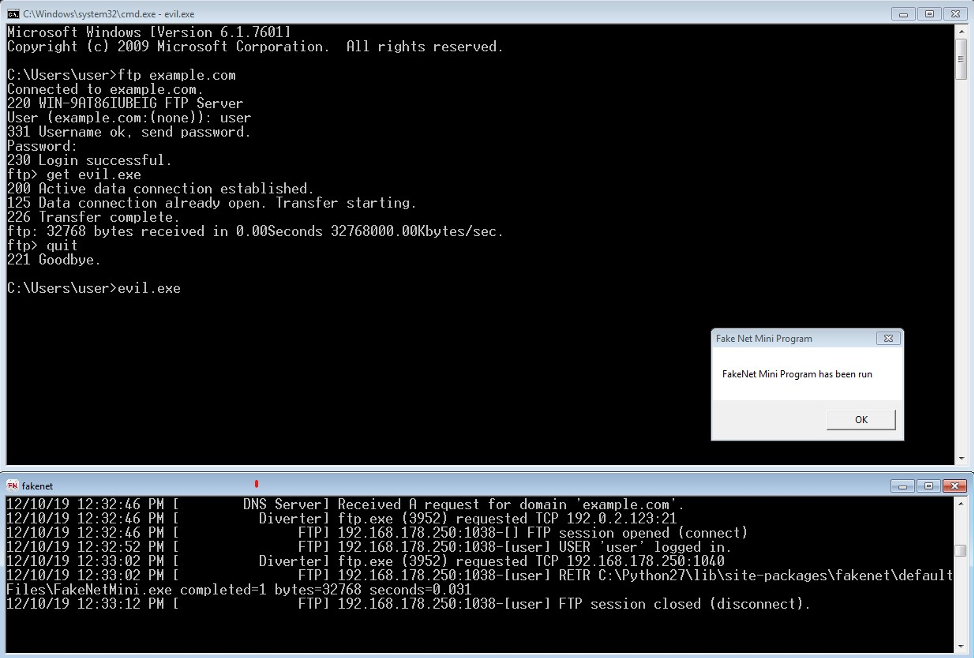
Most requests are adequately handled by this system. However, malware sometimes expects a file with a specific format, such as an image with an embedded PowerShell script, or an executable with a hash appended to the file for an integrity check . In cases like these, you can replace one of the default files with a file that meets the malware’s expectation. There is also an option in each of the relevant Listeners (modules that implement network protocols) configurations to modify the defaultFiles path. This allows FakeNet-NG to serve different files without overwriting or modifying default data. A customized FakeNet.html file is shown in Figure 2.
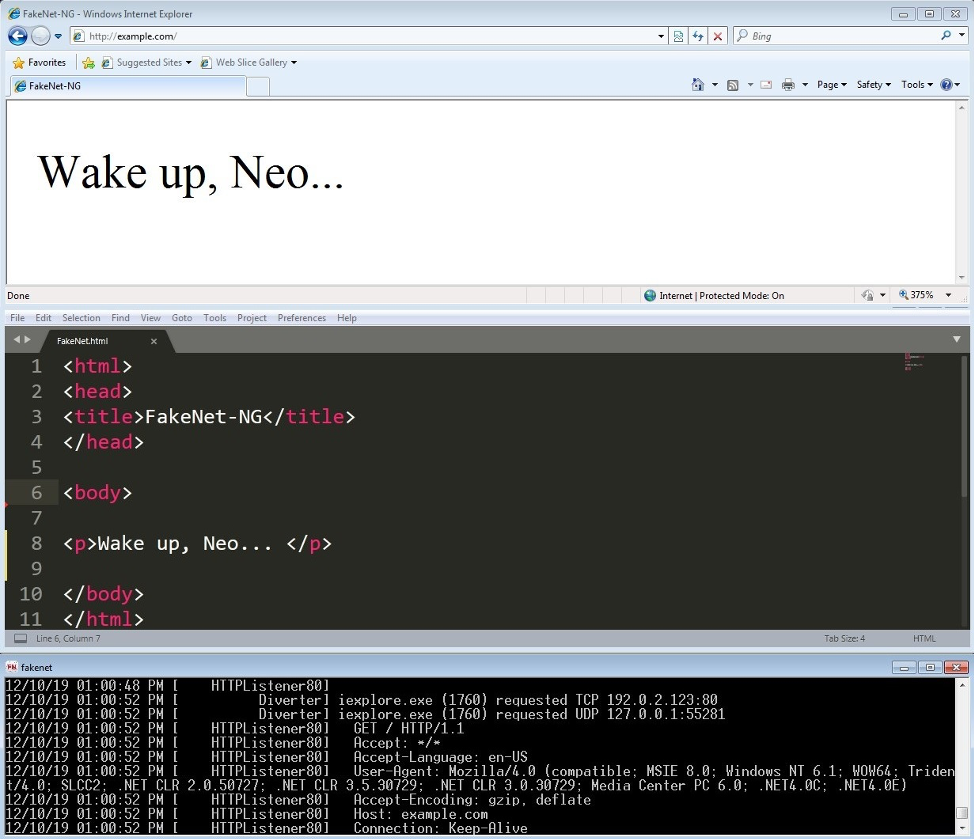
Stage 2: Custom Binary Protocols
Many malware samples implement custom binary protocols which require specific byte sequences. For example, malware in the GH0ST family may require each message to begin with a signature such as "GH0ST". The default FakeNet-NG RawListener responds to unknown requests with an echo, i.e. it sends the same data that it has received. This behavior is typically sufficient. However, in cases where a custom response is required, you can still send the data the malware expects.
Custom TCP and UDP responses are now possible with FakeNet-NG. Consider a hypothetical malware sample that beacons the string “Hello” to its command and control (C2) server and waits for a response packet that begins with “FLARE” followed by a numeric command (0-9). We will now demonstrate several interesting ways FakeNet-NG can handle this scenario.
Static Custom Response
You can configure how the TCP and/or UDP Raw Listeners respond to traffic. In this example we tell FakeNet-NG how to respond to any TCP raw request (no protocol detected). First uncomment the Custom configuration option in the RawTCPListener section of fakenet/configs/default.ini as illustrated in Figure 3.
| [RawTCPListener] Enabled: True Port: 1337 Protocol: TCP Listener: RawListener UseSSL: No Timeout: 10 Hidden: False # To read about customizing responses, see docs/CustomResponse.md Custom: sample_custom_response.ini |
Figure 3: Activate custom TCP response
Next configure the TcpRawFile custom response in fakenet\configs\sample_custom_response.ini as demonstrated in Figure 4. Make sure to comment-out or replace the default RawTCPListener instance.
| [ExampleTCP] InstanceName: RawTCPListener ListenerType: TCP TcpRawFile: flare_command.txt |
Figure 4: TCP static custom response specifications
Create the file fakenet\configs\flare_command.txt with the content FLARE0. TCP responses will now be generated from the contents of the file.
Dynamic Custom Response
Perhaps you want to issue commands dynamically rather than committing to a specific command in flare_command.txt. This can be achieved programmatically. Configure the TcpDynamic custom response in fakenet\configs\sample_custom_response.ini as demonstrated in Figure 5. Make sure to comment-out or replace the existing RawTCPListener instance.
| [ExampleTCP] InstanceName: RawTCPListener TcpDynamic: flare_command.py |
Figure 5: TCP dynamic custom response specifications
The file fakenet\configs\CustomProviderExample.py can be used as a template for our dynamic response file flare_command.py. We modify the HandleTcp() function and produce the new file fakenet\configs\flare_command.py as illustrated in Figure 6. Now you can choose each command as the malware executes. Figure 7 demonstrates issuing commands dynamically using this configuration.
import socket def HandleTcp(sock): while True: data = sock.recv(1024) if not data: resp = raw_input('\nEnter a numeric command: ') |
Figure 6: TCP dynamic response script
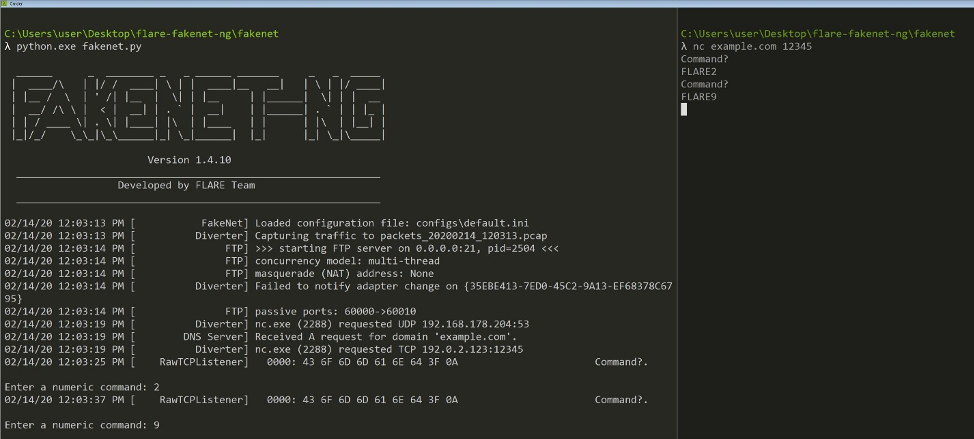
Stage 3: Custom HTTP Responses
Malware frequently implements its own encryption scheme on top of the popular HTTP protocol. For example, your sample may send an HTTP GET request to /comm.php?nonce=<random> and expect the C2 server response to be RC4 encrypted with the nonce value. This process is illustrated in Figure 8. How can we easily force the malware to execute its critical code path to observe or debug its behaviors?

For cases like these we recently introduced support for HTTP custom responses. Like TCP custom responses, the HTTPListener also has a new setting named Custom that enables dynamic HTTP responses. This setting also allows FakeNet-NG to select the appropriate responses matching specific hosts or URIs. With this feature, we can now quickly write a small Python script to handle the HTTP traffic dynamically based upon our malware sample.
Start by uncommenting the Custom configuration option in the HTTPListener80 section as illustrated in Figure 9.
| [HTTPListener80] Enabled: True Port: 80 Protocol: TCP Listener: HTTPListener UseSSL: No Webroot: defaultFiles/ Timeout: 10 #ProcessBlackList: dmclient.exe, OneDrive.exe, svchost.exe, backgroundTaskHost.exe, GoogleUpdate.exe, chrome.exe DumpHTTPPosts: Yes DumpHTTPPostsFilePrefix: http Hidden: False # To read about customizing responses, see docs/CustomResponse.md Custom: sample_custom_response.ini |
Figure 9: HTTP Listener configuration
Next configure the HttpDynamic custom response in fakenet\configs\sample_custom_response.ini as demonstrated in Figure 10. Make sure to comment-out or replace the default HttpDynamic instance.
| [Example2] ListenerType: HTTP HttpURIs: comm.php HttpDynamic: http_example.py |
Figure 10: HttpDynamic configuration
The file fakenet\configs\CustomProviderExample.py can be used as a template for our dynamic response file http_example.py. We modify the HandleRequest() function as illustrated in Figure 11. FakeNet-NG will now encrypt responses dynamically with the nonce.
import socket # To read about customizing HTTP responses, see docs/CustomResponse.md def HandleRequest(req, method, post_data=None): Parameters
response = 'Ahoy\r\n' nonce = req.path.split('=')[1] req.send_response(200) |
Figure 11: Dynamic HTTP request handler
Stage 4: Manual Custom Responses
For even more flexibility, the all-powerful networking utility netcat can be used to stand-in for FakeNet-NG listeners. For example, you may want to use netcat to act as a C2 server and issue commands dynamically during execution on port 80. Launch a netcat listener before starting FakeNet-NG, and traffic destined for the corresponding port will be diverted to the netcat listener. You can then issue commands dynamically using the netcat interface as seen in Figure 12.
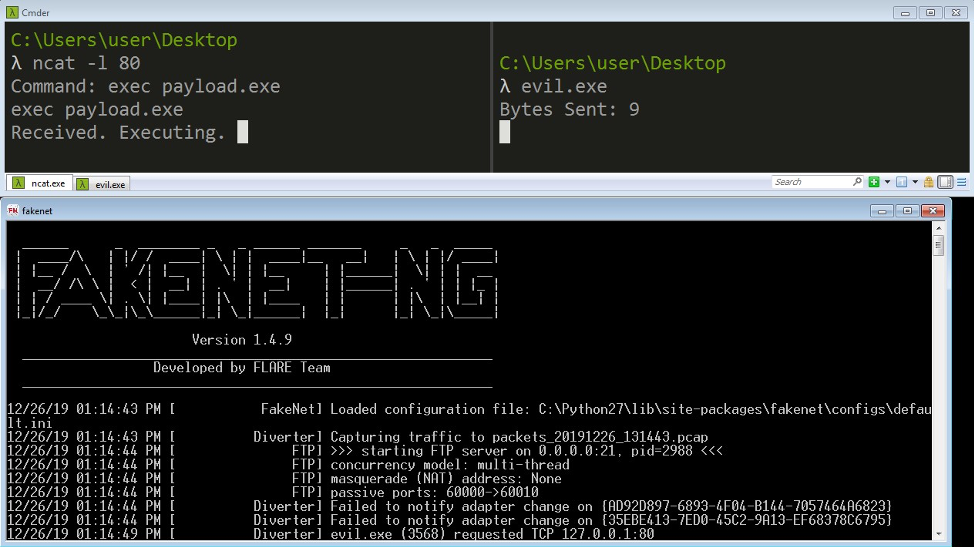
FakeNet-NG's custom response capabilities are diverse. Read the documentation to learn how to boost your custom response high score.
Stage 5: Blacklisting Processes
Some analysts prefer to debug malware from a separate system. There are many reasons to do this; most commonly to preserve the IDA database and other saved data when malware inevitably corrupts the environment. The process usually involves configuring two virtual machines on a host-only network. In this setup, FakeNet-NG intercepts network traffic between the two machines, which renders remote debugging impossible. To overcome this obstacle, we can blacklist the debug server by instructing FakeNet-NG to ignore traffic from the debug server process.
When debugging remotely with IDA Pro, the standard debug server process for a 32-bit Portable Executable is win32_remote.exe (or dbgsrv.exe for WinDbg). All you need to do is add the process names to the ProcessBlackList configuration as demonstrated in Figure 13. Then, the debug servers can still communicate freely with IDA Pro while all other network traffic is captured and redirected by FakeNet-NG.
| # Specify processes to ignore when diverting traffic. Windows example used here. ProcessBlackList: win32_remote.exe, dbgsrv.exe |
Figure 13: Modified configs/default.ini to allow remote debugging with IDA Pro
Blacklisting is also useful to filter out noisy processes from polluting Fakenet-NG captured network traffic. Examples include processes that attempt to update the Windows system or other malware analysis tools.
Additional settings are available for blacklisting ports and hosts. Please see the README for more details about blacklisting and whitelisting.
Stage 6: Executing Commands on Connection Events
Fakenet-NG can be configured to execute commands when a connection is made to a Listener. For example, this option can be used to attach a debugger to a running sample upon a connection attempt. Imagine a scenario where we analyze the packed sample named Lab18-01.exe from the Practical Malware Analysis labs. Using dynamic analysis, we can see that the malware beacons to its C2 server over TCP port 80 using the HTTP protocol as seen in Figure 14.
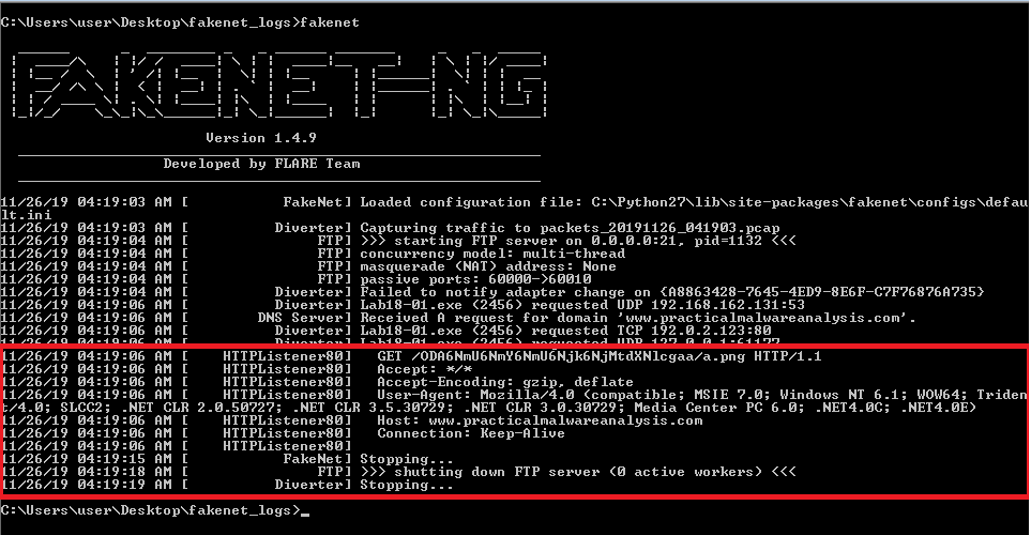
Wouldn’t it be nice if we could magically attach a debugger to Lab18-01.exe when a connection is made? We could speedrun the sample and bypass the entire unpacking stub and any potential anti-debugging tricks the sample may employ.
To configure Fakenet-NG to launch and attach a debugger to any process, modify the [HTTPListener80] section in the fakenet\configs\default.ini to include the ExecuteCmd option. Figure 15 shows an example of a complete [HTTPListener80] section.
| [HTTPListener80] Enabled: True Port: 80 Protocol: TCP Listener: HTTPListener UseSSL: No Webroot: defaultFiles/ Timeout: 10 DumpHTTPPosts: Yes DumpHTTPPostsFilePrefix: http Hidden: False # Execute x32dbg –p to attach to a debugger. {pid} is filled in automatically by Fakenet-NG ExecuteCmd: x32dbg.exe -p {pid} |
Figure 15: Execute command option to run and attach x32dbg
In this example, we configure the HTTPListener on port 80 to execute the debugger x32dbg.exe, which will attach to a running process whose process ID is determined at runtime. When a connection is made to HTTPListener, FakeNet-NG will automatically replace the string {pid} with the process ID of the process that makes the connection. For a complete list of supported variables, please refer to the Documentation.
Upon restarting Fakenet-NG and running the sample again, we see x32dbg launch and automatically attach to Lab18-01.exe. We can now use memory dumping tools such as Scylla or the OllyDumpEx plugin to dump the executable and proceed to static analysis. This is demonstrated in Figure 16 and Figure 17.
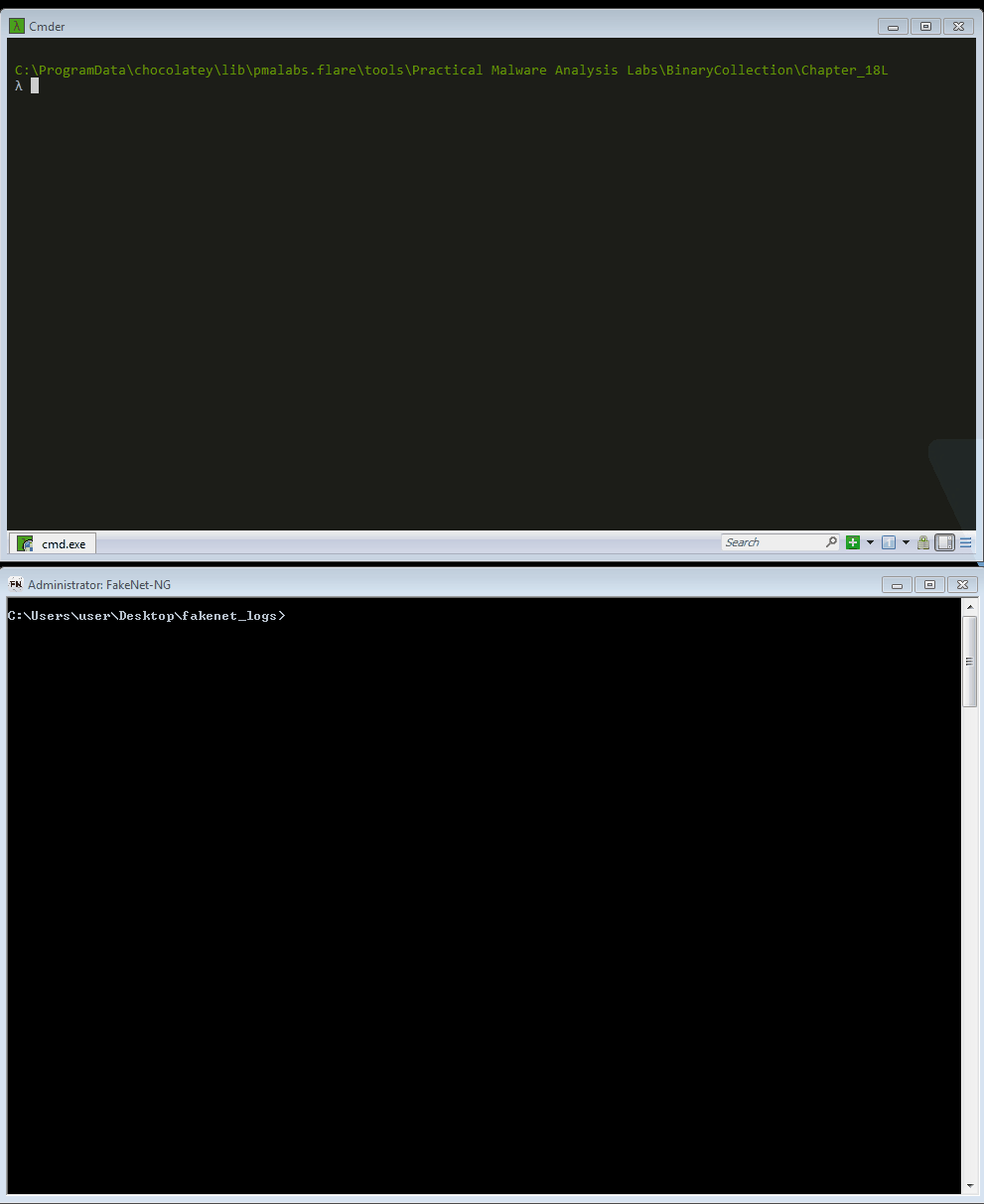
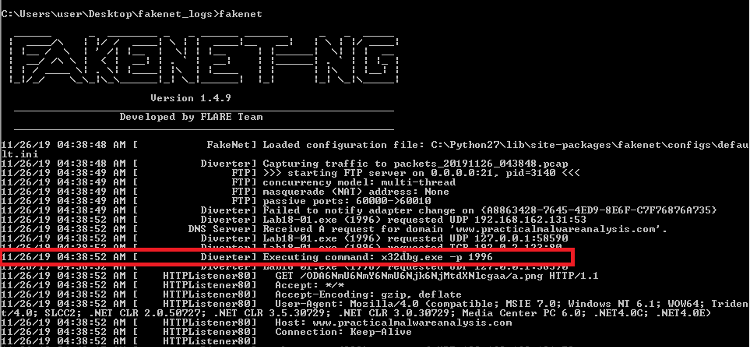
Stage 7: Decrypting SSL Traffic
Often malware uses SSL for network communication, which hinders traffic analysis considerably as the packet data is encrypted. Using Fakenet-NG's ProxyListener, you can create a packet capture with decrypted traffic. This can be done using the protocol detection feature.
The proxy can detect SSL, and "man-in-the-middle" the socket in SSL using Python's OpenSSL library. It then maintains full-duplex connections with the malware and with the HTTP Listener, with both sides unaware of the other. Consequently, there is a stream of cleartext HTTP traffic between the Proxy and the HTTP Listener, as seen in Figure 18.

In order to keep FakeNet-NG as simple as possible, current default settings for FakeNet-NG do not have the proxy intercept HTTPS traffic on port 443 and create the decrypted stream. To proxy the data you need to set the HTTPListener443 Hidden attribute to True as demonstrated in Figure 19. This tells the proxy to intercept packets and detect the protocol based on packet contents. Please read our blog post on the proxy and protocol detection to learn more about this advanced feature.
| [HTTPListener443] Enabled: True Port: 443 Protocol: TCP Listener: HTTPListener UseSSL: Yes Webroot: defaultFiles/ DumpHTTPPosts: Yes DumpHTTPPostsFilePrefix: http Hidden: True |
Figure 19: Hide the listener so the traffic will be proxied
We can now examine the packet capture produced by Fakenet-NG. The cleartext can be found in a TCP stream between an ephemeral port on localhost (ProxyListener) and port 80 on localhost (HTTPListener). This is demonstrated in Figure 20.
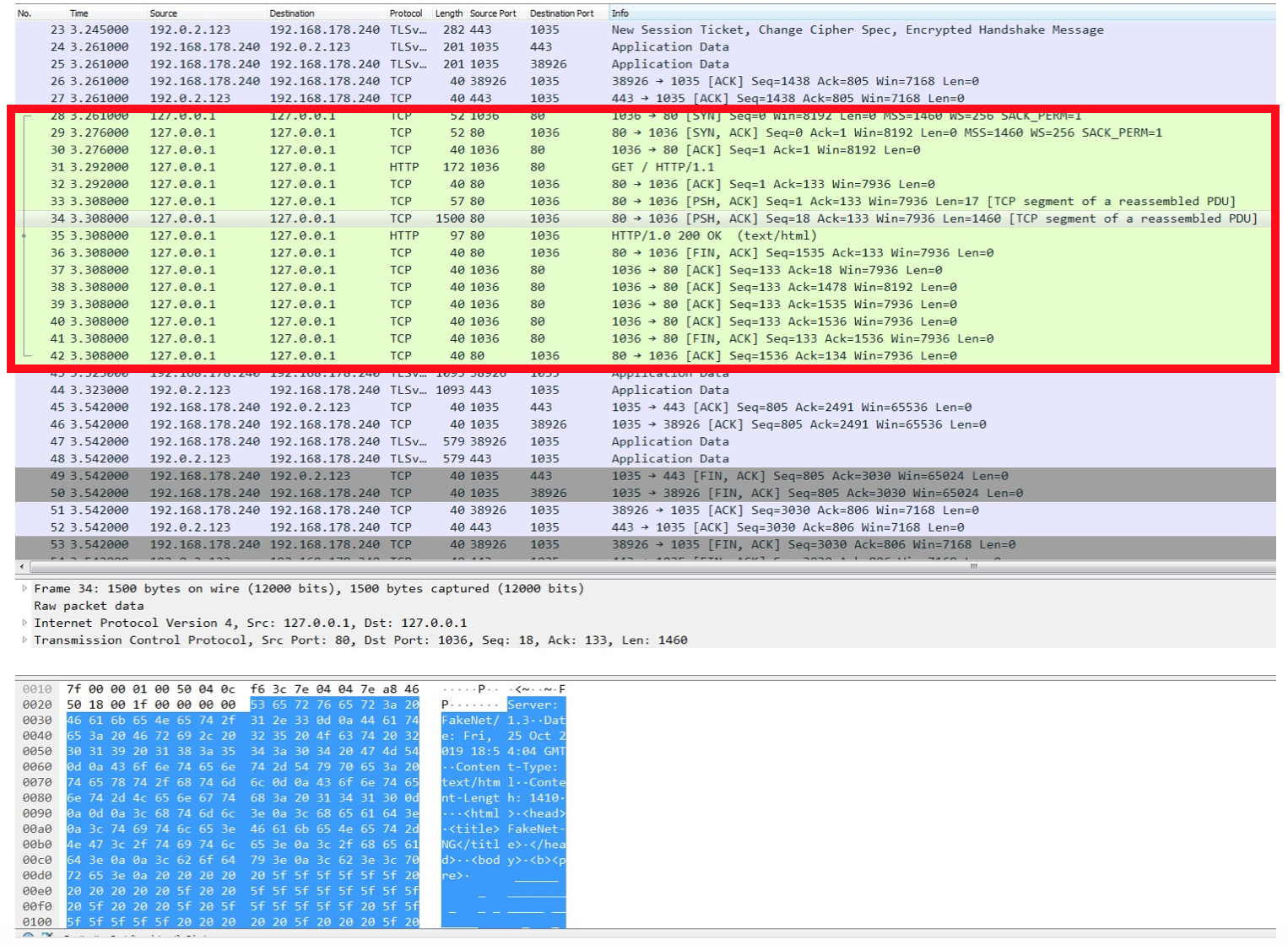
Conclusion (New Game+)
Fakenet-NG is the de facto standard network simulation tool for malware analysis. It runs without installation and is included in FLARE VM. In addition to its proven and tested default settings, Fakenet offers countless capabilities and configuration options. In this blog post we have presented several tricks to handle common analysis scenarios. To download the latest version, to see a complete list of all configuration options, or to contribute to Fakenet-NG, please see our Github repository.
